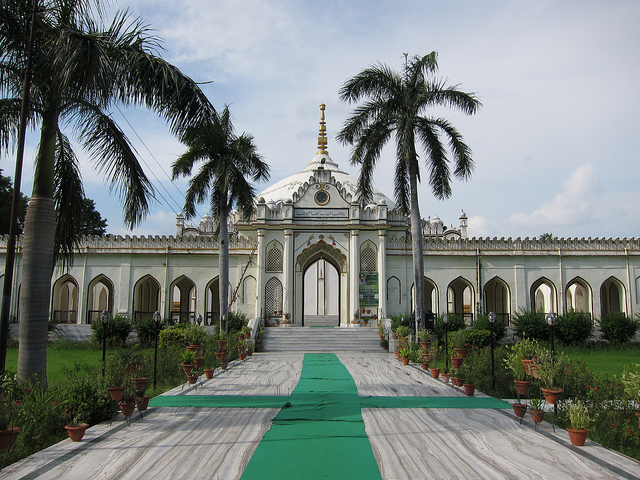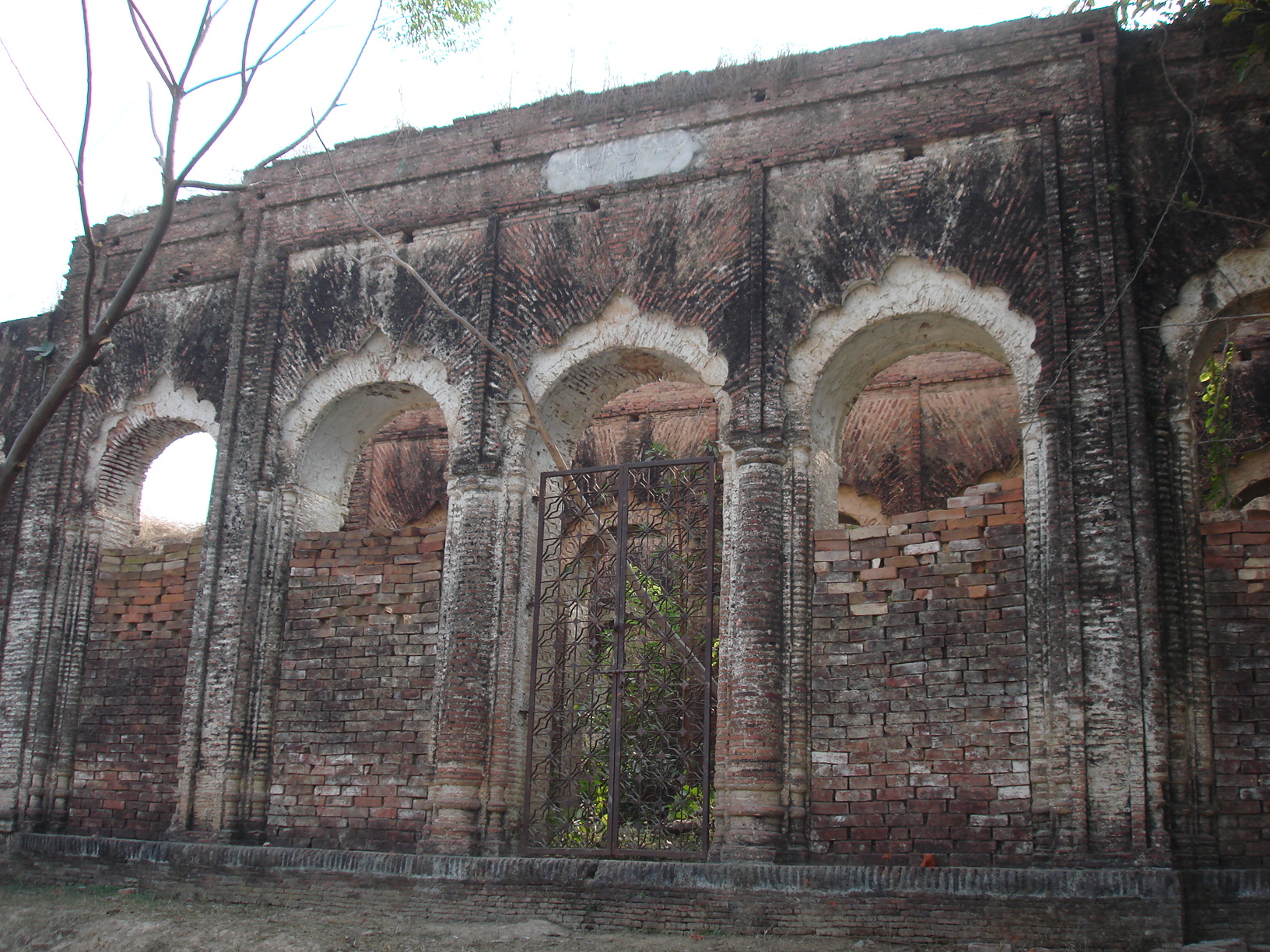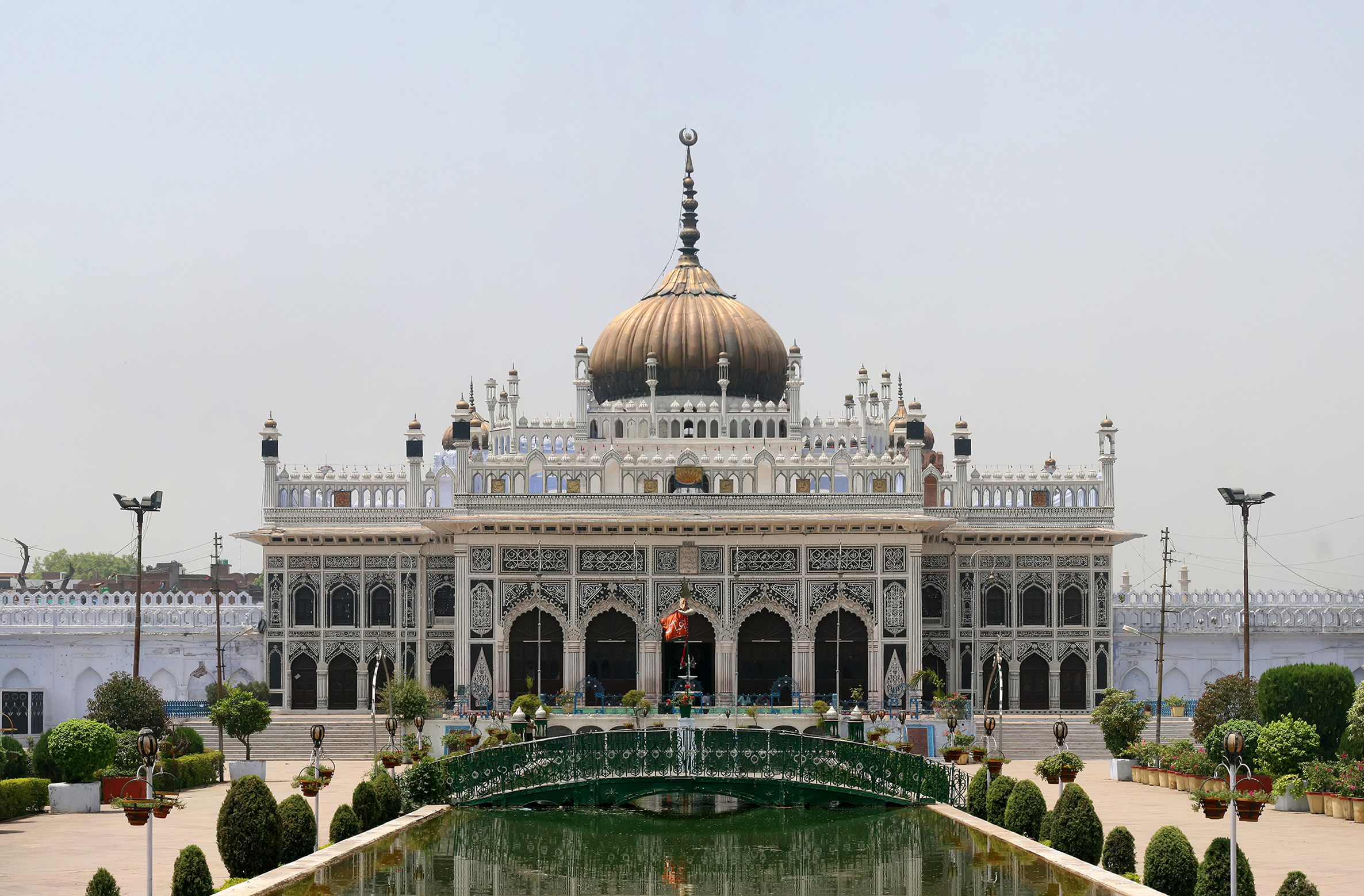|
Shah Najaf Imambara
Shah Najaf Imambara is one of the several imambaras in Lucknow. It is located centrally in the city and is less known than Asafi and Hussainabad Imambara. Location Shah Najaf Imambara is located in heart of the city on the Rana Pratap Road. It is close to the Sikandar Bagh Chauraha and is flanked by National Botanical Research Institute on one side. The front portion faces the Sahara Ganj Mall. The monuments is quite close to Hazratganj Market and close to many official building like Indra Bhawan and Jawahar Bhawan. Also, it lies quite close to the river Gomti on the rear side. A popular road is named as Shah Najaf Road in Lucknow. History Shah Najaf Imambara was constructed by Nawab Ghazi-ud-Din Haider, the last nawab wazir and the first King of the state of Awadh in 1816 - 1817. This imambara served as his mausoleum and was copy of Ali's tomb in Najaf in Iraq. Apart from Nawab Ghazi-ud-Din, his three wives Sarfaraz Mahal, Mubarak Mahal and Mumtaz Mahal were also burie ... [...More Info...] [...Related Items...] OR: [Wikipedia] [Google] [Baidu] |
Shah Najaf Mosque In 2013 2014-05-30 22-00
Shah (; fa, شاه, , ) is a royal title that was historically used by the leading figures of Iranian monarchies.Yarshater, EhsaPersia or Iran, Persian or Farsi, ''Iranian Studies'', vol. XXII no. 1 (1989) It was also used by a variety of Persianate societies, such as the Ottoman Empire, the Kazakh Khanate, the Khanate of Bukhara, the Emirate of Bukhara, the Mughal Empire, the Bengal Sultanate, historical Afghan dynasties, and among Gurkhas. Rather than regarding himself as simply a king of the concurrent dynasty (i.e. European-style monarchies), each Iranian ruler regarded himself as the Shahanshah ( fa, شاهنشاه, translit=Šâhanšâh, label=none, ) or Padishah ( fa, پادشاه, translit=Pâdešâh, label=none, ) in the sense of a continuation of the original Persian Empire. Etymology The word descends from Old Persian ''xšāyaθiya'' "king", which used to be considered a borrowing from Median, as it was compared to Avestan ''xšaθra-'', "power" and " ... [...More Info...] [...Related Items...] OR: [Wikipedia] [Google] [Baidu] |
Awadh
Awadh (), known in British historical texts as Avadh or Oudh, is a region in the modern Indian state of Uttar Pradesh, which was before independence known as the United Provinces of Agra and Oudh. It is synonymous with the Kośāla region of Hindu, Bauddh, and Jain scriptures. Awadh is bounded by the Ganges Doab to the southwest, Rohilkhand to the northwest, Nepal to the north, and Bhojpur- Purvanchal to the east. Its inhabitants are referred to as Awadhis. It was established as one of the twelve original subahs (top-level imperial provinces) under 16th-century Mughal emperor Akbar and became a hereditary tributary polity around 1722, with Faizabad as its initial capital and Saadat Ali Khan as its first Subadar Nawab and progenitor of a dynasty of Nawabs of Awadh (often styled Nawab Wazir al-Mamalik). The traditional capital of Awadh is Lucknow, also the station of the British Resident, which now is the capital of Uttar Pradesh. Etymology The word Awadh is supposed ... [...More Info...] [...Related Items...] OR: [Wikipedia] [Google] [Baidu] |
1817 Establishments In India
Events January–March * January 1 – Sailing through the Sandwich Islands, Otto von Kotzebue discovers New Year Island. * January 19 – An army of 5,423 soldiers, led by General José de San Martín, starts crossing the Andes from Argentina, to liberate Chile and then Peru. * January 20 – Ram Mohan Roy and David Hare found Hindu College, Calcutta, offering instructions in Western languages and subjects. * February 12 – Battle of Chacabuco: The Argentine–Chilean patriotic army defeats the Spanish. * March 3 ** President James Madison vetoes John C. Calhoun's Bonus Bill. ** The U.S. Congress passes a law to split the Mississippi Territory, after Mississippi drafts a constitution, creating the Alabama Territory, effective in August. * March 4 – James Monroe is sworn in as the fifth President of the United States. * March 21 – The flag of the Pernambucan Revolt is publicly blessed by the dean of Recife Cathedral, Brazil. ... [...More Info...] [...Related Items...] OR: [Wikipedia] [Google] [Baidu] |
Islam In India
Islam is India's second-largest religion, with 14.2% of the country's population, approximately 172.2 million people identifying as adherents of Islam in 2011 Census. India is also the country with the second or third largest number of Muslims in the world. The majority of India's Muslims are Sunni, with Shia making up 13% of the Muslim population. Islam spread in Indian communities along the Arab coastal trade routes in Gujarat and along the Malabar Coast shortly after the religion emerged in the Arabian Peninsula. Islam arrived in the inland of Indian subcontinent in the 7th century when the Arabs conquered Sindh and later arrived in Punjab and North India in the 12th century via the Ghaznavids and Ghurids conquest and has since become a part of India's religious and cultural heritage. The Barwada Mosque in Ghogha, Gujarat built before 623 CE, Cheraman Juma Mosque (629 CE) in Methala, Kerala and Palaiya Jumma Palli (or The Old Jumma Masjid, 628–630 CE) in Kilakar ... [...More Info...] [...Related Items...] OR: [Wikipedia] [Google] [Baidu] |
Shia Islam
Shīʿa Islam or Shīʿīsm is the second-largest branch of Islam. It holds that the Islamic prophet Muhammad designated ʿAlī ibn Abī Ṭālib as his successor (''khalīfa'') and the Imam (spiritual and political leader) after him, most notably at the event of Ghadir Khumm, but was prevented from succeeding Muhammad as the leader of the Muslims as a result of the choice made by some of Muhammad's other companions (''ṣaḥāba'') at Saqifah. This view primarily contrasts with that of Sunnī Islam, whose adherents believe that Muhammad did not appoint a successor before his death and consider Abū Bakr, who was appointed caliph by a group of senior Muslims at Saqifah, to be the first rightful (''rāshidūn'') caliph after Muhammad. Adherents of Shīʿa Islam are called Shīʿa Muslims, Shīʿītes, or simply Shīʿa or Shia. Shīʿa Islam is based on a ''ḥadīth'' report concerning Muhammad's pronouncement at Ghadir Khumm.Esposito, John. "What Everyone Nee ... [...More Info...] [...Related Items...] OR: [Wikipedia] [Google] [Baidu] |
Imambaras Of Lucknow
Lucknow is a city of imambaras as it has a large number of imambaras among which are some very famous. Lucknow the center of Azadari in India Lucknow is the center of Azadari in India because of the large number of Imambaras in the city. There are multiple replicas of every holy shia shrine which reflects the efforts of the Nawabs of Awadh (Oudh) to promote Azadari in the Indian sub-continent. Lucknow holds the privilege of holding the Shabi-e-Rauza (Replicas of the original Shrines or Tombs) of all the Members of Muhammad's family, collectively known as Ahlebait. Not only the Nawabs but also the noble men and the locals built the Shrines(Shabi-e-Rauza) of Ahlebait in Lucknow. These shrines were built for the people who were unable to visit the original Shrines in the Middle East region. Imambara An "Imambara" or an "Imambargah" means (House of Imam or Court of Imam); this word is a North Indian origin. An Imambara is also known as Hussaniya, Ashoor Khana. An Imambara is ... [...More Info...] [...Related Items...] OR: [Wikipedia] [Google] [Baidu] |
Imambara Ghufran Ma'ab
Imambara Ghufran Ma'ab (Urdu: , ) in Lucknow, India is an imambara (a building used to commemorate the Muharram commemoration period in which Muslims, particularly Shias mourning the tragedy of Karbala in which Imam Hussain was killed) constructed by Shia cleric Ayatollah Syed Dildar Ali Naseerabadi Al Jayasi (also known as Ghufran-Ma'ab) in the early 1790s.Cultural History Of Medieval India By Meenakshi Khanna The imambara The imambara is named ''Ghufran Ma'ab'' after popular name of Ayatollah Syed Dildar Ali 'Gufran Ma'ab' and is major religious culture center of Lucknow.[...More Info...] [...Related Items...] OR: [Wikipedia] [Google] [Baidu] |
Chattar Manzil
The Chattar Manzil ( ur, , hi, छतर मंज़िल), or Umbrella Palace is a building in Lucknow in Uttar Pradesh which served as a palace for the rulers of Awadh and their wives. Coordinates:26°85′N 80°93′E Construction and architecture It was constructed by order of Nawab Ghazi Uddin Haider and completed after his death by his successor, Nawab Nasir Uddin Haider. The Chattar Manzil stand on the banks of the River Gomti. The Chattar Manzil consisted of a ''Bari'' (larger) Chattar Manzil and ''Chhoti'' (smaller) Chattar Manzil, however only the larger one still exists. These two buildings were examples of the Indo-European-Nawabi architectural style, even though the Bari Chattar Manzil has been altered over the years. The palaces were named after the chattris (umbrella-shaped domes) on the octagonal pavilions, which crown the buildings. The imposing building has large underground rooms and a dome surmounted by a gilt umbrella. Usage The Palace has g ... [...More Info...] [...Related Items...] OR: [Wikipedia] [Google] [Baidu] |
Chota Imambara
Chota Imambara, also known as Imambara Hussainabad Mubarak is an imposing monument located in the city of Lucknow, Uttar Pradesh, India. It took 54 years to finalize it. Built as an imambara or a congregation hall for Shia Muslims, by Muhammad Ali Shah, the Nawab of Awadh in 1838, it was to serve as a mausoleum for himself and his mother, who is buried beside him. The significance of Panjetan, the holy five, is once again emphasized here with five main doorways. This Imambara consist of two halls and a Shehnasheen (a platform where the Zarih of Imam Husain is kept.) Zarih is the replica of that protective grill or structure which is kept on the grave of Imam Husain at Karbala, Iraq. The large green and white bordered hall of Azakhana is richly decorated with chandeliers and a good number of crystal glass lamp-stands. In fact, it was for this profuse decoration that the Imambara was referred by European visitors and writers as The Palace of Lights. The exterior is very ... [...More Info...] [...Related Items...] OR: [Wikipedia] [Google] [Baidu] |
Iraq
Iraq,; ku, عێراق, translit=Êraq officially the Republic of Iraq, '; ku, کۆماری عێراق, translit=Komarî Êraq is a country in Western Asia. It is bordered by Turkey to the north, Iran to the east, the Persian Gulf and Kuwait to the southeast, Saudi Arabia to the south, Jordan to the southwest and Syria to the west. The capital and largest city is Baghdad. Iraq is home to diverse ethnic groups including Iraqi Arabs, Kurds, Turkmens, Assyrians, Armenians, Yazidis, Mandaeans, Persians and Shabakis with similarly diverse geography and wildlife. The vast majority of the country's 44 million residents are Muslims – the notable other faiths are Christianity, Yazidism, Mandaeism, Yarsanism and Zoroastrianism. The official languages of Iraq are Arabic and Kurdish; others also recognised in specific regions are Neo-Aramaic, Turkish and Armenian. Starting as early as the 6th millennium BC, the fertile alluvial plains between Iraq's Tigris and Euphrates ... [...More Info...] [...Related Items...] OR: [Wikipedia] [Google] [Baidu] |
Najaf
Najaf ( ar, ٱلنَّجَف) or An-Najaf al-Ashraf ( ar, ٱلنَّجَف ٱلْأَشْرَف), also known as Baniqia ( ar, بَانِيقِيَا), is a city in central Iraq about 160 km (100 mi) south of Baghdad. Its estimated population in 2013 was 1,000,000 people. It is the capital of Najaf Governorate. It is widely considered amongst the holiest cities of Shia Islam and one of its spiritual capitals, whilst also remaining the center of Shia political power in Iraq. Name According to Ibn al-Manzur, the word, "najaf" (), literally means a high and rectangular place around which water is accumulated, although the water does not go above its level. Al-Shaykh al-Saduq appeals to a hadith from Imam al-Sadiq (a), claiming that "Najaf" comes from the phrase, "nay jaff" which means "the nay sea has dried" which gradually changed into "Najaf". "Najaf" is usually accompanied with the adjective, "al-Ashraf" (dignified). According to the author of ''al-Hawza al-'ilmiyya ... [...More Info...] [...Related Items...] OR: [Wikipedia] [Google] [Baidu] |









